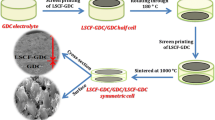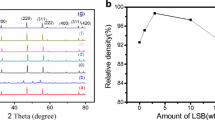Abstract
A composite electrolyte Ce0.8Sm0.2O1.9-BaCe0.8Sm0.2O2.9 (SDC-BCS) material for co-ionic conducting solid oxide fuel cells was prepared by microwave-assisted sol-gel technique. The crystallization, morphology, and sintering characteristics were investigated by X-ray diffraction and scanning electron microscopy. The obtained SDC-BCS composite electrolyte powders distribute uniformly, and SDC and BCS crystalline grains play a role as matrix for each other in the composite electrolyte. Anode-supported solid oxide fuel cells of NiO-Ce0.8Sm0.2O1.9/Ce0.8Sm0.2O1.9-BaCe0.8Sm0.2O2.9/Ce0.8Sm0.2O1.9-SrCo0.9Ti0.1O2.55 (NiO-SDC/SDC-BCS/SDC-SCT) were fabricated based on the nanocomposite electrolyte powders. The electrochemical performances were tested at 500–650 °C using humidified hydrogen as fuel. Results demonstrated that the anode-supported half cells could be sintered at 1,300 °C with a dense electrolyte layer and a porous anode structure. Moreover, the single cell with 40-μm-thick electrolyte layer achieved an open-circuit voltage (OCV) of 0.77 V and a maximum power density of 621 mW cm−2 at 650 °C.






Similar content being viewed by others
References
Tsipis EV, Kharton VV (2008) Electrode materials and reaction mechanisms in solid oxide fuel cells: a brief review. J Solid State Electrochem 12:1039–1060
Singh P, Goodenough JB (2013) Monoclinic Sr1 − x Na x SiO3 − 0.5x : new superior oxide ion electrolytes. J Am Chem Soc 135:10149–10154
Zheng KQ, Ni M, Sun Q, Shen LY (2013) Mathematical analysis of SOFC based on co-ionic conducting electrolyte. Acta Mech Sinica-Prc 29:388–394
Demin A, Tsiakaras P, Gorbova E, Hramova S (2004) A SOFC based on a co-ionic electrolyte. J Power Sources 131:231–236
Iwahara H (1992) Oxide-ionic and protonic conductors based on perovskite-type oxides and their possible applications. Solid State Ion 52:99–104
Medvedev D, Maragou V, Pikalova E, Demin A, Tsiakaras P (2013) Novel composite solid state electrolytes on the base of BaCeO3 and CeO2 for intermediate temperature electrochemical devices. J Power Sources 221:217–227
Stefan E, Tsekouras G, Irvine JTS (2013) Development and performance of MnFeCrO4-based electrodes for solid oxide fuel cells. Adv Energy Mater 3:1454–1462
Jacobson AJ (2010) Materials for solid oxide fuel cells. Chem Mater 22:660–674
Ding CS, Hashida T (2011) Synthesis and evaluation of NiO-Ce0.8Sm0.2O1.9 nanocomposite powders for low-temperature solid oxide fuel cells. Int J Hydrogen Energy 36:5567–5573
Wang Y, Wang H, Liu T, Chen FL, Xia CR (2013) Improving the chemical stability of BaCe0.8Sm0.2O3 − δ electrolyte by Cl doping for proton-conducting solid oxide fuel cell. Electrochem Commun 28:87–90
Ai N, Chen KF, Jiang SP (2013) A fundamental study of infiltrated CeO2 and (Gd,Ce)O2 nanoparticles on the electrocatalytic activity of Pt cathodes of solid oxide fuel cells. Solid State Ion 233:87–94
Atkinson A (1997) Chemically-induced stresses in gadolinium-doped ceria solid oxide fuel cell electrolytes. Solid State Ion 95:249–258
Zhang JT, Liang FL, Chi B, Pu J, Lian L (2012) Enhanced electrochemical performance of BaZr0.1Ce0.7Y0.1Yb0.1O3 − δ electrodes for hydrogen and methane oxidation in solid oxide fuel cells by Pd or Cu0.5Pd0.5 impregnation. J Power Sources 200:29–33
Zhang LM, Yang WS (2012) High-performance low-temperature solid oxide fuel cells using thin proton-conducting electrolyte with novel cathode. Int J Hydrogen Energy 37:8635–8640
Lin Y, Ran R, Guo YM, Zhou W, Cai R, Wang J et al (2010) Proton-conducting fuel cells operating on hydrogen, ammonia and hydrazine at intermediate temperatures. Int J Hydrogen Energy 35:2637–2642
Sun WP, Jiang YZ, Wang YF, Fang SM, Zhu ZW, Liu W (2011) A novel electronic current-blocked stable mixed ionic conductor for solid oxide fuel cells. J Power Sources 196:62–68
Douvarzides S, Coutelieris F, Tsiakaras P (2004) Exergy analysis of a solid oxide fuel cell power plant fed by either ethanol or methane. J Power Sources 131:224–230
Ding CS, Sato K, Mizusaki J (2012) A comparative study of NiO–Ce0.9Gd0.1O1.95 nanocomposite powders synthesized by hydroxide and oxalate co-precipitation methods. Ceram Int 38:85–92
Kahlaoui M, Chefi S, Inoubli A, Madani A, Chefi C (2013) Synthesis and electrical properties of co-doping with La3+, Nd3+, Y3+, and Eu3+ citric acid-nitrate prepared samarium-doped ceria ceramics. Ceram Int 39:3873–3879
Kahlaoui M, Inoubli A, Chefi S, Kouki A, Madani A, Chedi C (2013) Electrochemical and structural study of Ce0.8Sm0.2 − x La x O1.9 electrolyte materials for SOFC. Ceram Int 39:6175–6182
Stijepovic I, Darbandi AJ, Srdic VV (2013) Conductivity of Co and Ni doped lanthanum-gallate synthesized by citrate sol-gel method. Ceram Int 39:1495–1502
Hierso J, Boy P, Valle K, Vulliet J, Blein F, Laberty-Robert C et al (2013) Nanostructured ceria based thin films ({<=}1 {mu}m) As cathode/electrolyte interfaces. J Solid State Chem 197:113–119
Inada M, Nishinosono A, Kamada K, Enomoto N, Hojo J (2008) Microwave-assisted sol-gel process for production of spherical mesoporous silica materials. J Mater Sci 43:2362–2366
Wang ZH, Kale GM, Tang X (2014) Sintering behaviour and ac conductivity of dense Ce0.8Gd0.2O1.9 solid electrolyte prepared employing single-step and two-step sintering process. J Mater Sci 49:3010–3015
Mamak M, Metraux GS, Petrov S, Coombs N, Ozin GA, Green MA (2003) Lanthanum strontium manganite/yttria-stabilized zirconia nanocomposites derived from a surfactant assisted, co-assembled mesoporous phase. J Am Chem Soc 125:5161–5175
Yu B, Zhang WQ, Xu JM, Chen L, Luo X, Stephan K (2012) Preparation and electrochemical behavior of dense YSZ film for SOEC. Int J Hydrogen Energy 37:12074–12080
Wang ZH, Kale GM, Ghadiri M (2012) Sol-gel production of Ce0.8Gd0.2O1.9 nanopowders using sucrose and pectin as organic precursors. J Am Ceram Soc 95:2863–2868
Pal J, Deb MK (2014) Microwave green synthesis of PVP-stabilised gold nanoparticles and their adsorption behaviour for methyl orange. J Exp Nanosci 9:432–443
Bi L, Zhang SQ, Zhang L, Tao ZT, Wang HQ, Liu W (2009) Indium as an ideal functional dopant for a proton-conducting solid oxide fuel cell. Int J Hydrogen Energy 34:2421–2425
Acknowledgments
The authors would like to thank the financial support from the Chinese Natural Science Foundation on contract Grant Nos. 51102107 and 51202080, Anhui Science and Technology Project (No. 1206c0805038), and Huainan Science and Technology Project (No. 2010A03203).
Author information
Authors and Affiliations
Corresponding authors
Electronic supplementary material
Below is the link to the electronic supplementary material.
ESM 1
(DOC 305 kb)
Rights and permissions
About this article
Cite this article
Tian, D., Liu, W., Chen, Y. et al. Low-temperature co-sintering of co-ionic conducting solid oxide fuel cells based on Ce0.8Sm0.2O1.9-BaCe0.8Sm0.2O2.9 composite electrolyte. Ionics 21, 823–828 (2015). https://doi.org/10.1007/s11581-014-1220-2
Received:
Revised:
Accepted:
Published:
Issue Date:
DOI: https://doi.org/10.1007/s11581-014-1220-2




